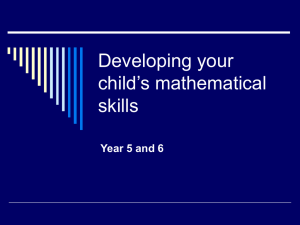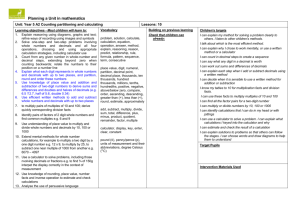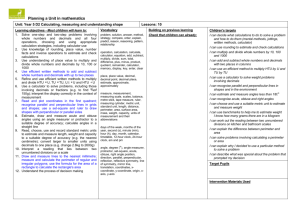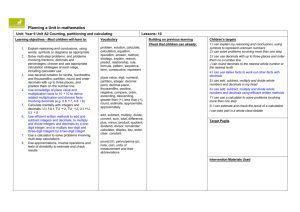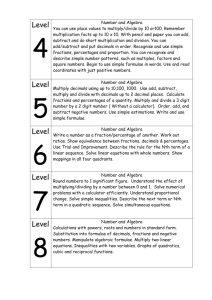Blocks
advertisement
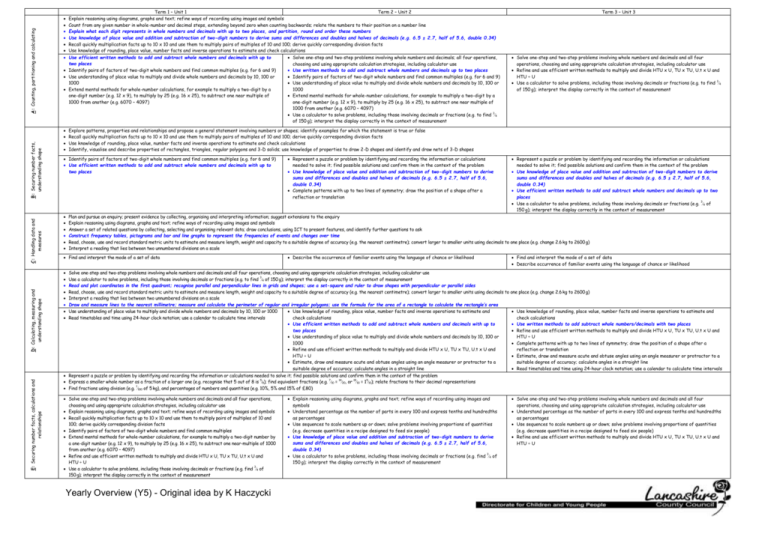
A: Counting, partitioning and calculating B: Securing number facts, understanding shape C: Handling data and measures D: Calculating, measuring and understanding shape E: Securing number facts, calculations and relationships Term 1 – Unit 1 Term 2 – Unit 2 Explain reasoning using diagrams, graphs and text; refine ways of recording using images and symbols Count from any given number in whole-number and decimal steps, extending beyond zero when counting backwards; relate the numbers to their position on a number line Explain what each digit represents in whole numbers and decimals with up to two places, and partition, round and order these numbers Use knowledge of place value and addition and subtraction of two-digit numbers to derive sums and differences and doubles and halves of decimals (e.g. 6.5 ± 2.7, half of 5.6, double 0.34) Recall quickly multiplication facts up to 10 x 10 and use them to multiply pairs of multiples of 10 and 100; derive quickly corresponding division facts Use knowledge of rounding, place value, number facts and inverse operations to estimate and check calculations Use efficient written methods to add and subtract whole numbers and decimals with up to two places Identify pairs of factors of two-digit whole numbers and find common multiples (e.g. for 6 and 9) Use understanding of place value to multiply and divide whole numbers and decimals by 10, 100 or 1000 Extend mental methods for whole-number calculations, for example to multiply a two-digit by a one-digit number (e.g. 12 x 9), to multiply by 25 (e.g. 16 x 25), to subtract one near multiple of 1000 from another (e.g. 6070 – 4097) Solve one-step and two-step problems involving whole numbers and decimals and all four operations, choosing and using appropriate calculation strategies, including calculator use Refine and use efficient written methods to multiply and divide HTU x U, TU x TU, U.t x U and HTU ÷ U 3 Use a calculator to solve problems, including those involving decimals or fractions (e.g. to find 4 of 150 g); interpret the display correctly in the context of measurement Explore patterns, properties and relationships and propose a general statement involving numbers or shapes; identify examples for which the statement is true or false Recall quickly multiplication facts up to 10 x 10 and use them to multiply pairs of multiples of 10 and 100; derive quickly corresponding division facts Use knowledge of rounding, place value, number facts and inverse operations to estimate and check calculations Identify, visualise and describe properties of rectangles, triangles, regular polygons and 3-D solids; use knowledge of properties to draw 2-D shapes and identify and draw nets of 3-D shapes Identify pairs of factors of two-digit whole numbers and find common multiples (e.g. for 6 and 9) Use efficient written methods to add and subtract whole numbers and decimals with up to two places Solve one-step and two-step problems involving whole numbers and decimals; all four operations, choosing and using appropriate calculation strategies, including calculator use Use written methods to add and subtract whole numbers and decimals up to two places Identify pairs of factors of two-digit whole numbers and find common multiples (e.g. for 6 and 9) Use understanding of place value to multiply and divide whole numbers and decimals by 10, 100 or 1000 Extend mental methods for whole-number calculations, for example to multiply a two-digit by a one-digit number (e.g. 12 x 9), to multiply by 25 (e.g. 16 x 25), to subtract one near multiple of 1000 from another (e.g. 6070 – 4097) Use a calculator to solve problems, including those involving decimals or fractions (e.g. to find 34 of 150 g); interpret the display correctly in the context of measurement Term 3 – Unit 3 Represent a puzzle or problem by identifying and recording the information or calculations needed to solve it; find possible solutions and confirm them in the context of the problem Use knowledge of place value and addition and subtraction of two-digit numbers to derive sums and differences and doubles and halves of decimals (e.g. 6.5 ± 2.7, half of 5.6, double 0.34) Complete patterns with up to two lines of symmetry; draw the position of a shape after a reflection or translation Represent a puzzle or problem by identifying and recording the information or calculations needed to solve it; find possible solutions and confirm them in the context of the problem Use knowledge of place value and addition and subtraction of two-digit numbers to derive sums and differences and doubles and halves of decimals (e.g. 6.5 ± 2.7, half of 5.6, double 0.34) Use efficient written methods to add and subtract whole numbers and decimals up to two places Use a calculator to solve problems, including those involving decimals or fractions (e.g. 34 of 150 g); interpret the display correctly in the context of measurement Plan and pursue an enquiry; present evidence by collecting, organising and interpreting information; suggest extensions to the enquiry Explain reasoning using diagrams, graphs and text; refine ways of recording using images and symbols Answer a set of related questions by collecting, selecting and organising relevant data; draw conclusions, using ICT to present features, and identify further questions to ask Construct frequency tables, pictograms and bar and line graphs to represent the frequencies of events and changes over time Read, choose, use and record standard metric units to estimate and measure length, weight and capacity to a suitable degree of accuracy (e.g. the nearest centimetre); convert larger to smaller units using decimals to one place (e.g. change 2.6 kg to 2600 g) Interpret a reading that lies between two unnumbered divisions on a scale Find and interpret the mode of a set of data Describe the occurrence of familiar events using the language of chance or likelihood Find and interpret the mode of a set of data Describe occurrence of familiar events using the language of chance or likelihood Solve one-step and two-step problems involving whole numbers and decimals and all four operations, choosing and using appropriate calculation strategies, including calculator use Use a calculator to solve problems, including those involving decimals or fractions (e.g. to find 34 of 150 g); interpret the display correctly in the context of measurement Read and plot coordinates in the first quadrant; recognise parallel and perpendicular lines in grids and shapes; use a set-square and ruler to draw shapes with perpendicular or parallel sides Read, choose, use and record standard metric units to estimate and measure length, weight and capacity to a suitable degree of accuracy (e.g. the nearest centimetre); convert larger to smaller units using decimals to one place (e.g. change 2.6 kg to 2600 g) Interpret a reading that lies between two unnumbered divisions on a scale Draw and measure lines to the nearest millimetre; measure and calculate the perimeter of regular and irregular polygons; use the formula for the area of a rectangle to calculate the rectangle’s area Use understanding of place value to multiply and divide whole numbers and decimals by 10, 100 or 1000 Use knowledge of rounding, place value, number facts and inverse operations to estimate and Use knowledge of rounding, place value, number facts and inverse operations to estimate and Read timetables and time using 24-hour clock notation; use a calendar to calculate time intervals check calculations check calculations Use efficient written methods to add and subtract whole numbers and decimals with up to Use written methods to add subtract whole numbers/decimals with two places two places Refine and use efficient written methods to multiply and divide HTU x U, TU x TU, U.t x U and Use understanding of place value to multiply and divide whole numbers and decimals by 10, 100 or HTU ÷ U 1000 Complete patterns with up to two lines of symmetry; draw the position of a shape after a Refine and use efficient written methods to multiply and divide HTU x U, TU x TU, U.t x U and reflection or translation HTU ÷ U Estimate, draw and measure acute and obtuse angles using an angle measurer or protractor to a Estimate, draw and measure acute and obtuse angles using an angle measurer or protractor to a suitable degree of accuracy; calculate angles in a straight line suitable degree of accuracy; calculate angles in a straight line Read timetables and time using 24-hour clock notation; use a calendar to calculate time intervals Represent a puzzle or problem by identifying and recording the information or calculations needed to solve it; find possible solutions and confirm them in the context of the problem 5 7 14 19 9 Express a smaller whole number as a fraction of a larger one (e.g. recognise that 5 out of 8 is 8); find equivalent fractions (e.g. 10 = 20, or 10 = 1 10); relate fractions to their decimal representations 1 Find fractions using division (e.g. 100 of 5 kg), and percentages of numbers and quantities (e.g. 10%, 5% and 15% of £80) Solve one-step and two-step problems involving whole numbers and decimals and all four operations, choosing and using appropriate calculation strategies, including calculator use Explain reasoning using diagrams, graphs and text; refine ways of recording using images and symbols Recall quickly multiplication facts up to 10 x 10 and use them to multiply pairs of multiples of 10 and 100; derive quickly corresponding division facts Identify pairs of factors of two-digit whole numbers and find common multiples Extend mental methods for whole-number calculations, for example to multiply a two-digit number by a one-digit number (e.g. 12 x 9), to multiply by 25 (e.g. 16 x 25), to subtract one near-multiple of 1000 from another (e.g. 6070 – 4097) Refine and use efficient written methods to multiply and divide HTU x U, TU x TU, U.t x U and HTU ÷ U Use a calculator to solve problems, including those involving decimals or fractions (e.g. find 34 of 150 g); interpret the display correctly in the context of measurement Yearly Overview (Y5) - Original idea by K Haczycki Explain reasoning using diagrams, graphs and text; refine ways of recording using images and symbols Understand percentage as the number of parts in every 100 and express tenths and hundredths as percentages Use sequences to scale numbers up or down; solve problems involving proportions of quantities (e.g. decrease quantities in a recipe designed to feed six people) Use knowledge of place value and addition and subtraction of two-digit numbers to derive sums and differences and doubles and halves of decimals (e.g. 6.5 ± 2.7, half of 5.6, double 0.34) Use a calculator to solve problems, including those involving decimals or fractions (e.g. find 34 of 150 g); interpret the display correctly in the context of measurement Solve one-step and two-step problems involving whole numbers and decimals and all four operations, choosing and using appropriate calculation strategies, including calculator use Understand percentage as the number of parts in every 100 and express tenths and hundredths as percentages Use sequences to scale numbers up or down; solve problems involving proportions of quantities (e.g. decrease quantities in a recipe designed to feed six people) Refine and use efficient written methods to multiply and divide HTU x U, TU x TU, U.t x U and HTU ÷ U

